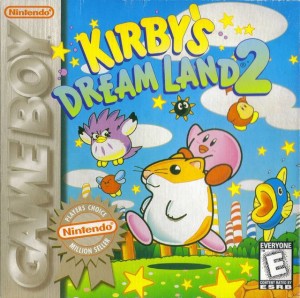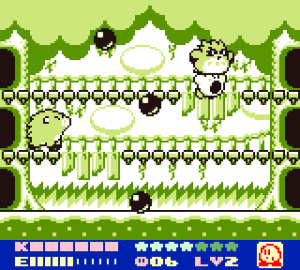Kirby’s Dream Land 2 – Game Boy
 Platform: Game Boy
Platform: Game Boy
Release Date (NA): May 1st, 1995
Developer: HAL Laboratory
Publisher: Nintendo
Genre: Platformer
Nerd Rating: 9 out of 10
When it comes to tiny screens full of simple shapes and relegated to gray/green and black, there are inherent limitations to what a video game can do. It takes a measure of skill to crank out something fun while being aware of these limitations, and Kirby’s Dream Land 2 nails it! Whereas Kirby’s first adventure in Dream Land took me 30 to 45 minutes and cost maybe 3 or 4 lives, Dream Land 2 ate up several hours of my time over 3 days and forced me into using multiple continues. This one is harder, longer, and more in-depth. The original Dream Land is plenty fun to play through, but Kirby’s second appearance on the Game Boy offers up plenty of reasons to come back and actually keep playing it.

Kirby, about to free a friend!

One of the most badass combinations possible – Coo and Cutter!
The preceding Kirby’s Adventure introduced Kirby’s trademark “copy” ability, and Dream Land 2 takes it a step further by adding in 3 “friends” to help along the way. With 7 copy abilities (ice, fire, shock, spike, cutter, stone, and parasol) and 3 friends (Kine (fish), Coo (owl), and Rick (hamster?)), and the combination of each of these, there are 21 possible combinations. I at first thought that there would be a lot of redundancy between all these choices, but it turns out that each is unique and particularly suited to different situations throughout the game. Kirby can also use the copy abilities or friends by themselves, and along with “regular Kirby,” this nets a whopping 32 iterations of our main character. And you will have to ditch friends and powerups for “regular Kirby” to do his thing at times.

A hamster named Rick…yeah, ok…
Dream Land 2 is divided into 7 levels with between 3 and 7 stages in each plus a boss stage. Once completed, the player is free to explore previous areas and can easily go in, grab an item, and exit without penalty for use in tougher stages or those that require special abilities. Basic gameplay is the same as the first Dream Land. Kirby can suck up enemies and either spit or swallow; if he swallows certain foes, he gains one of the powers listed above. During this time his usual inhale maneuver is replaced with a special move and he is also unable to inflate and float. His animal buddies are located in sub-boss rooms. When the boss is defeated, a critter pops out of the bag.
 New powers (both copy abilities and friends) add an enormous variety to gameplay. Some stages can be completed in seconds with certain powerups, and some are exceedingly difficult without them. Friends add constant modifications to Kirby’s interaction with the environment, for instance the fish can swim against currents that Kirby can’t, and
New powers (both copy abilities and friends) add an enormous variety to gameplay. Some stages can be completed in seconds with certain powerups, and some are exceedingly difficult without them. Friends add constant modifications to Kirby’s interaction with the environment, for instance the fish can swim against currents that Kirby can’t, and  the owl can fly against winds too strong for our puffy protagonist. All of this adds up to complex levels with a range of features, flying, swimming, jumping, and falling all come into play; levels are presented both horizontally and vertically; “moving screens” are a common occurrence, also in vertical and horizontal forms. Each copy ability can break a certain type of block, and coupled with the increased access offered by Kirby’s friends, some areas remain accessible only by certain combinations.
the owl can fly against winds too strong for our puffy protagonist. All of this adds up to complex levels with a range of features, flying, swimming, jumping, and falling all come into play; levels are presented both horizontally and vertically; “moving screens” are a common occurrence, also in vertical and horizontal forms. Each copy ability can break a certain type of block, and coupled with the increased access offered by Kirby’s friends, some areas remain accessible only by certain combinations.

Water + electricity = lightbulb-spitting fish. Duh!
Moving through these new worlds is still pretty easy, but plenty of bosses and sub-bosses are thrown in to keep the player on their toes. Sub-bosses appear frequently in 7 varieties (one for each ability) and until one learns their patterns, they can be a major pain. End of level bosses up the ante considerably with high hit points and moderately complicated patterns. What I found most interesting is that despite all the help Kirby can gather along the way, it’s his inhaling and inflating abilities that come in most handy. He can’t float with either copy abilities or friends in tow, and copy abilities further limit his practice of inhaling. Ditching both before a boss battle almost always makes the fight easier, especially when coordinating attacks with enemy patterns.
What really stands out about Kirby’s Dream Land 2 is the the amount of hidden elements present. On the save file itself it tells the player what percentage of the game has been completed. Just when you think you’ve beaten the game, you’re greeted with only 76% completion. For what seems like such a small game on such a limited platform, there are a number of secrets to be found, mostly in the form of the 7 rainbow drops. Finding these requires increasingly complex combinations of copy abilities and/or assistance from friends and some are hidden extremely well. Procuring these is even more of a challenge, but the reward is a whole new ending. You’ve got to go back and fight King Dedede again, but then a vicious air battle takes place with the “Dark Matter,” in 2 forms no less, and Kirby is now armed with a special sword. Though the “regular” game sports a moderate overall difficulty, this hidden layer proves much more difficult.

If you work really really hard, you’ll earn the pleasure of fighting this insanely difficult battle.
Even after the real ending, some exploring (and possibly research) will be needed to reach 100%. I was shocked by the sheer amount of material crammed into Dream Land 2 and while Kirby’s reputation has held firm over the years, the Game Boy isn’t exactly known for its engaging and in-depth library. Granted there are tons and tons of Game Boy games I’ve never played, but so far, Kirby’s Dream Land 2 might just be the best due to its impressive scope if nothing else.
The graphics are rather plain as to be expected. Simple shapes populate most of the game, and the real focus here is on gameplay. The visuals get the job done and convey a fairly wide variety of environments even if they do leave a lot to the imagination. Music has the familiar whimsical Kirby feel to it though its not quite as catchy or memorable as that in the first Dream Land.
 When I first dug Dream Land 2 out of a pile of caseless handheld games and resolved to play it after finishing Kirby’s Dream Land, I was expecting a quick, light, cartoonish affair similar to the first. It might retain the same core gameplay, but Dream Land 2 superseded any and all expectations with its hours worth of levels, encouragement of exploration, and wealth of secrets. It’s been a long time since I’ve seen a franchise make a leap like that, though admittedly I still haven’t played Kirby’s Adventure, released on the NES between these first 2 installments in Dream Land. Not all gamers will be able to tolerate such a lengthy and exhaustive journey via the simple machinations of the Game Boy, but it’s worth a try just to see what Dream Land 2 is capable of. Folks, this is about as good as it gets for such a simple handheld and proves that masterful level design and well planned mechanics are truly at the core of what makes a great game.
When I first dug Dream Land 2 out of a pile of caseless handheld games and resolved to play it after finishing Kirby’s Dream Land, I was expecting a quick, light, cartoonish affair similar to the first. It might retain the same core gameplay, but Dream Land 2 superseded any and all expectations with its hours worth of levels, encouragement of exploration, and wealth of secrets. It’s been a long time since I’ve seen a franchise make a leap like that, though admittedly I still haven’t played Kirby’s Adventure, released on the NES between these first 2 installments in Dream Land. Not all gamers will be able to tolerate such a lengthy and exhaustive journey via the simple machinations of the Game Boy, but it’s worth a try just to see what Dream Land 2 is capable of. Folks, this is about as good as it gets for such a simple handheld and proves that masterful level design and well planned mechanics are truly at the core of what makes a great game.
Reviewed by The Cubist
Share This Post







Recent Comments